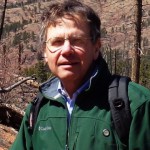Find out how much federal land ownership the Constitution really authorizes! Get Rob’s book, The Original Constitution: What It Actually Said and Meant.
****
Mary Taylor Young’s work, Rocky Mountain National Park: The First 100 Years (2014) contains this profile (p.151) of George B. Hartzog, Jr., the Assistant Superintendent of the park from 1955 to 1957:
“He went on to become National Park Service director from 1964 to 1972. . . He oversaw the acquisition of seventy-two new sites for parks, seashores, and historical monuments . . . Under his leadership, the National Park System more than doubled in size . . . Park Service historian Robert M. Utley described Hartzog as ‘the greatest director in the history of the service.’”
Keep in mind that whatever may have been the benefits from expanding the National Park System, Hartzog’s legacy was one of bigger government and less human freedom. Less freedom because when land becomes part of a national park, citizens may no longer buy, sell, occupy, own, or lease that land. Citizens may not use the land for anything but a narrow range of activities. Classification as a national park also impairs state government’s jurisdiction over territory within its borders.
Ms. Young did not mention that Hartzog is famous (or infamous) for another reason: He pioneered the notorious “Washington Monument Syndrome”—the bureaucratic strategy of blackmailing politicians and the public by diverting available funds to unpopular uses and away from popular ones. The July 5, 2008 Washington Post summarized it this way: “In 1969, when his budget was cut by [President] Nixon, Mr. Hartzog made a daring countermove: He closed all the national parks, including the Washington Monument and Grand Canyon, two days a week.”
Of course, Nixon should have fired Hartzog—who was, in any event, a Democratic holdover hostile to the conservative message the voters had sent in the 1968 election. But it took the unprincipled Nixon three years to dump him. According to the Post, “In 1972, Mr. Hartzog revoked a permit to use a private dock in Biscayne National Park in Florida. The permit was used by Bebe Rebozo, a close friend of Nixon’s. The president promptly fired Mr. Hartzog.”
Here’s more about what the Post wrote about this consummate bureaucrat:
“In almost nine years as director, Mr. Hartzog used personal charisma, political savvy and deep-rooted knowledge of the nation’s park system to increase the scope of Park Service programs and to raise their popularity. He ran the agency like a benevolent dictator . . . .
“He added more than 70 new areas to the Park Service, totaling 2.7 million acres, and doubled attendance at the nation’s parks and historic sites. He was also the only Park Service director to be profiled in the New Yorker magazine . . .
“‘He was an empire builder,’ said Robert M. Utley, who was the Park Service’s chief historian under Mr. Hartzog. ‘His vision fit right into Lyndon Johnson’s Great Society ideas.’
“In 1966, Mr. Hartzog was a key proponent of the National Historic Preservation Act, which increased the range of historically significant properties and created the National Register of Historic Places. The register is administered by the Park Service. . . .
Clemson University memorializes this empire-building bureaucrat with a lecture series in his honor. The Park Service recognizes outstanding volunteers with “Hartzog Awards.”
Now, here’s a question for you: How often have you seen that kind of respect and recognition awarded to a public servant (other than perhaps Ronald Reagan) who actually expanded freedom or trimmed government?
Government will continue to grow and freedom diminish as long as we celebrate people like Hartzog and disregard those anonymous public servants (and believe me, they exist) who trim the size of government and give the public top value for taxes paid.








